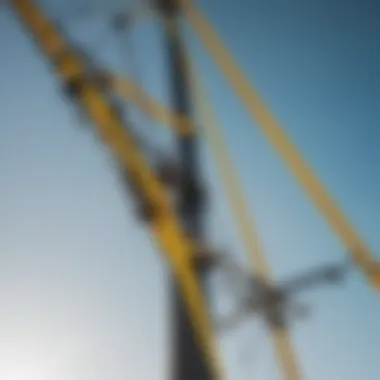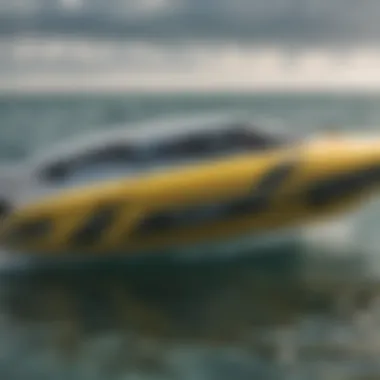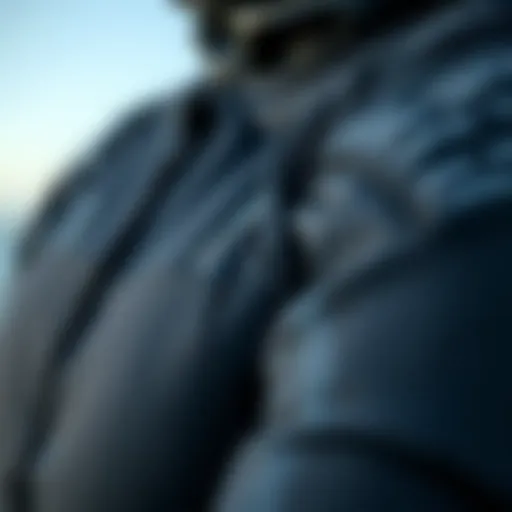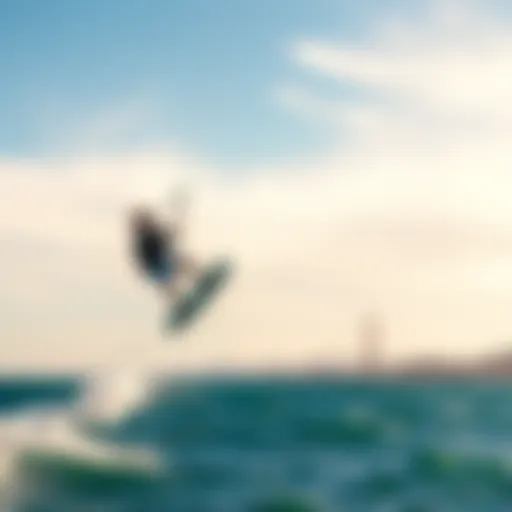Understanding Naish Foil Parts for Kiteboarding


Intro
Navigating the waters of kiteboarding is a unique blend of skill, thrill, and the right gear. With many components to consider, Naish foil parts stand out as vital players in this exciting sport. Understanding these parts not only enhances the performance of your ride but also enriches the overall kiteboarding experience.
Foil boarding, in particular, relies heavily on the specific designs and materials used in each component. Discerning kiteboarders, whether beginners or seasoned pros, can realize improvements in speed, stability, and maneuverability simply by choosing the right parts. In this comprehensive guide, we will dissect the various elements that comprise Naish foils, examining how they contribute to your kiteboarding adventures.
Gear Insights
Latest Gear Reviews
When it comes to kiteboarding, keeping up with the latest gear can put you ahead of the curve. For instance, the Naish Hover 135 is drawing attention this season. It's designed with a lightweight carbon construction, enhancing both agility and strength on the water. Riders have noted how its impressive lift allows for smoother transitions and easier take-offs. Reviews highlight that those who use the Hover find themselves feeling more confident in their jumps.
Another worthy mention is the Naish Thrust WS 1800, a wing renowned for its stability. This provides comfort to even the most neurotic kiteboarders as they tackle rougher seas. Customers rave about its responsive feel which keeps them in touch with the water, resulting in a more profound connection while riding.
Essential Gear for Beginners
For newbies to kiteboarding, familiarizing oneself with essential gear can be a pivotal step in mastering the sport. To begin with, the Naish Glide 1800 is an excellent option. Its size allows beginners to experience effortless gliding, helping them gain confidence quickly.
Moreover, a reliable kite is just as crucial. The Naish Boxer’s stability makes it a natural fit for those just starting. A simple set-up helps avoid any initial overwhelm, allowing newcomers to focus on enjoying the ride rather than fidgeting with gear.
"Choosing your gear correctly can make or break your first few experiences in kiteboarding."
Techniques and Tips
Advanced Tricks and Techniques
As you grow comfortable with your Naish foil, it’s time to elevate your skills. Perhaps you want to try the downloop, which involves turning the kite aggressively while maintaining speed. This maneuver, when executed correctly, can propel you into stylish jumps and thrilling turns.
Another technique worth mastering is the carving turn. Here’s where you tilt the board and edge harder, allowing you to shift your weight to maintain balance while creating a beautiful arc in the water. This not only gives you flow in your riding but also draws the attention of fellow kiteboarders.
Safety Practices for Kiteboarders
Safety should always be top of mind. Using the right safety gear, like a helmet and impact vest, adds an extra layer of protection as you push your limits. Also, learn the wind conditions you are comfortable with before heading out. Understanding how the wind interacts with the foil can make a world of differnece in your ride.
Stay clear of crowded areas and keep an eye on other riders. A moment's distraction can lead to incidents, which no kiteboarding enthusiast wants to experience.
By diving into the world of Naish foil parts and understanding their functions, you equip yourself not just for an enjoyable ride, but also a journey filled with growth and adventure. Choosing the right components, harnessing innovative designs, and practicing essential techniques will make your kiteboarding experience rewarding.
Preamble to Naish Foil Technology
Understanding the intricacies of Naish foil technology is crucial for anyone involved in kiteboarding, whether you're a beginner trying to catch your first wave or a seasoned pro looking to push your limits. Naish has carved out a significant niche in foiling, offering products that stand up to the demands of the sport while providing riders with the tools they need to harness the winds and waves to their advantage. What makes Naish products worth acknowledging is their innovative spirit, known for marrying performance with user-friendly features.
The Evolution of Foiling in Kiteboarding
Foiling has undoubtedly transformed the landscape of kiteboarding. It’s a technology that allows riders to fly above the water's surface, significantly reducing drag and opening up new possibilities for speed and maneuverability. Over the years, foiling has evolved from experimental prototypes to mainstream products, and Naish has been at the forefront of this evolution. Early designs were often cumbersome, limiting the potential of many riders; however, as materials and aerodynamics advanced, so did the performance capabilities of foils.
Naish adapted quickly, taking notices of market trends while integrating customer feedback to deliver top-notch equipment. They embraced lightweight materials and new engineering techniques that not only improved the overall efficiency but also made the sport more accessible to a wider audience. From the first iterations using heavy metals to today’s carbon fiber constructions, the advancements are nothing short of revolutionary.
Naish's Contribution to the Foiling Landscape
Naish's role in shaping foiling technology cannot be understated. They have continuously invested in research and development to ensure that their products are not just competitive but also reliable. Their designs often reflect a deep understanding of rider needs. By focusing on customizable components, Naish has created systems that accommodate various styles and skill levels, allowing riders to tailor their setups to their preferences.
"Innovation in foil technologies isn’t just about new materials or shapes; it’s about enhancing the rider experience. Naish is leading the charge, ensuring that every kiteboarder can find their perfect foil."
Not only does Naish produce high-quality components, but they’re also committed to education within the kiteboarding community. Through workshops and demonstrations, they aim to demystify the technical aspects of foiling. This educational approach allows users to maximize the capability of their gear, resulting in more informed and engaged riders. As a whole, Naish has done a commendable job in contributing to the culture and technology of kiteboarding, and it remains a key player worth watching as the sport continues to evolve.
Key Components of Naish Foil Parts
Understanding the key components of Naish foil parts is crucial for anyone looking to enhance their experience on the water. Each part of the foil plays an instrumental role, contributing to overall performance, stability, and ride quality. Kiteboarders, from beginners to seasoned pros, will benefit immensely by knowing how each component interacts and what functionalities they serve.
The differences in materials, designs, and features translate directly to varying experiences while foiling. Making informed decisions about these components can mean the difference between a smooth ride and a frustrating session. Let’s dive into the pillars of Naish foil parts to gain a complete grasp of what they're all about.
Masts: The Backbone of the Foil
Masts in a foil setup are often termed the backbone, and rightly so. They serve as the vertical structure that elevates the wings above the water, acting as a bridge between the rider and the lift generated by the wings below.
Materials Used in Naish Masts
The materials that make up Naish masts play a pivotal role in overall performance. Most masts are crafted from either aluminum or carbon fiber. Carbon fiber, for instance, is generally lighter and more rigid, allowing for quicker response times and better speed. Conversely, aluminum masts are known for their durability and are typically less expensive.


A unique selling point of Naish's masts is their blend of lightweight construction and sturdiness. With a high-strength to weight ratio, these masts make it easier for riders to maintain control even in challenging conditions. The choice between these materials will largely depend on preference, as riders might prioritize weight reduction or resilience in their foiling experience.
Different Lengths and Their Impacts
Mast length can significantly influence how you ride. Generally, longer masts enable a deeper lift, which is ideal for choppy waters, preventing many surface disturbances from affecting your flight. However, longer masts can be tricky in shallow waters, potentially risking collisions with the seabed.
Riders often find themselves choosing between short and long masts depending on local conditions and personal skill level. Each length has its place, enhancing versatility in various environments. Too short, and you lose stability; too long, and agility might become an issue.
Connection Mechanisms
Connection mechanisms include how the mast attaches to the wing and the fuselage. Naish foils utilize a robust yet streamlined connection that allows easy assembly and disassembly. This system enhances portability, which is crucial for travelers who move from one foiling location to another.
A unique feature of these connection mechanisms is their adaptability across different mast and wing setups. This modularity allows riders to tailor their foiling experience based on water conditions and personal preferences, from quick turns to constant speed rides. However, if not properly maintained, any weak connections can lead to performance issues.
Wings: Where Lift Happens
The wings are the real heroes when it comes to lift generation in any foiling setup. They are designed to create lift by manipulating water flow, transforming potential energy from the wind into upward thrust.
Front and Rear Wings Explained
In a typical setup, the front and rear wings function together to provide optimal lift and stability. The front wing generally has a greater surface area, allowing for the lifting force necessary to elevate the board.
The unique aspect of Naish’s front wings is their innovative design that maximizes efficiency while minimizing drag. On the other hand, rear wings facilitate control, helping to stabilize the board during turns and maneuvers. Each plays a significant role in your overall experience, affecting everything from speed to stability.
Aspect Ratios and Performance
Aspect ratio is critical in how wings perform. A higher aspect ratio typically means enhanced performance in speed and efficiency. These wings are slender and long, allowing smooth airflow, reducing drag during high-speed rides.
Naish wings often showcase a balanced aspect ratio, catering to various styles and preferences. Choosing the right aspect ratio depends on the type of riding you plan to do; higher ratios suit those chasing speed, while lower ratios are perfect for beginners seeking lift.
Choosing the Right Wing for Conditions
Selecting the appropriate wing is not just about personal preference; it also revolves around the conditions. Riders must consider factors such as wind strength and water surface when making their choice.
Naish provides a range of wings tailored to different conditions, making it easier for users to align their setup with the environment. The unique feature of this customization is the diversity it offers, whether chasing high speed, stability, or increased lift in gusty winds.
Fuselage: The Core Assembly
The fuselage connects the mast and wings and acts as the base that houses these components together. Its design profoundly impacts the overall stability and handling of the foil setup.
Configurations and Their Benefits
Fuselage configurations can vary widely, from short to long setups. Short fuselages tend to be more agile and responsive, whereas longer fuselages provide additional stability.
The configurations that Naish offers are thoughtfully crafted to suit a variety of riding styles. A unique benefit of these setups is the seamless transition between different configurations, allowing riders to adapt their boards for different scenarios or conditions efficiently.
Connecting Masts and Wings
The way masts connect to wings through the fuselage is not merely about stability, but also about performance tuning. Naish's connection system facilitates quick adjustments without hassle, which is especially attractive for those looking to experiment with different setups.
This adaptability allows for an increased level of customization, catering to both novice and advanced riders’ requirements. A downside could be the necessity of high maintenance to ensure these connections remain robust and damage free over time.
Adjustability Features
Adjustability is a major selling point of Naish's fuselage setups. Depending on your level of experience and riding style, you'll find features that can help enhance performance in specific conditions.
This level of customization, however, can lead to confusion for some riders. Proper knowledge on how to adjust can optimize performance, while also ensuring that the setup remains safe and reliable.
Struts: Stabilizing Your Ride
Struts play an equally important role in maintaining overall stability during foiling. By connecting the wings to the fuselage, they provide support that is essential for smooth rides.
Functions of Struts in Foiling
Struts serve as stabilizers, ensuring the wings maintain the correct angle during operation. This accuracy helps prevent unwanted maneuvering during high-speed actions, leading to overall safer rides.
A unique aspect of Naish struts is their aerodynamic design, which minimizes drag while enhancing stability. Without proper functioning struts, even the best setups can become cumbersome, making the experience less enjoyable.
Material Considerations


The materials that make up the struts are critical. Many are crafted from durable composites that can withstand the pressures of high-speed foiling, yet remain lightweight.
Using advanced manufacturing techniques, Naish ensures that their struts remain resilient under various conditions. The trade-off is typically a higher cost, but the safety and performance benefits far outweigh it.
Strut Lengths and Performance
Just like with masts, the lengths of struts can affect performance. Longer struts can improve lift and stability but can also become cumbersome in some situations.
Riders must analyze their specific needs and experiences when selecting strut lengths. The beauty of Naish's offerings is the variety available; this allows riders to optimize their setups easily based on the conditions they face.
Understanding these key components of Naish foil parts fundamentally enhances your kiteboarding experience. The knowledge gathered from this section will empower riders to make informed decisions about their setups and improve their overall performance on the water.
Performance Aspects of Naish Foil Parts
In the realm of kiteboarding, the performance of Naish foil parts plays a pivotal role in enhancing the rider’s experience. Understanding how these components work together can be the difference between a ride filled with excitement and one marred by frustration. This section delves into efficiency factors and customization options, both of which are vital for optimizing your setup and ensuring a seamless glide across the water.
Efficiency Factors
Lift-to-Drag Ratio
The lift-to-drag ratio is a fundamental metric for foiling performance. Essentially, it assesses the efficiency of the foil in producing lift while minimizing resistance. A high lift-to-drag ratio means you can lift off the water with less force, allowing for a smoother ride. This is crucial for riders who want to maximize performance without exhausting themselves.
The unique aspect of this ratio in Naish foils is their precision engineering. Naish has invested significant research into refining wing shapes to achieve optimal airflow, resulting in greater lift with less drag. This feature makes Naish foils particularly appealing to both novice and seasoned kiteboarders.
"The lift-to-drag ratio is like the foil's efficiency report card; the higher it is, the better your ride will be!"
However, it's essential to balance this feature with the type of conditions you'll face. In choppy waters, a high ratio may offer an advantage; conversely, on smoother surfaces, other characteristics might take precedence.
Speed and Maneuverability
Speed and maneuverability are interlinked factors that dictate how a foil performs on the water. Speed is not just about zooming across the surface; it also influences your ability to respond to sudden changes in conditions, which can be paramount for safety. Meanwhile, maneuverability pertains to how quickly and easily a rider can change direction, something that is often essential during dynamic riding situations.
Naish foils shine in this area due to their lightweight materials and streamlined designs. The agility of these foils allows for sharp turns and quick adjustments, making them a popular choice among advanced riders who frequently encounter shifting winds and waves.
Nevertheless, speed can sometimes come at the cost of stability. Riders need to be mindful that pursuing high speed can lead to a loss of control, particularly for those new to foiling.
Customization for Performance Optimization
Customization opens a world of possibilities for kiteboarders looking to fine-tune their equipment to their specific needs. Every rider's preferences and skills vary, making the ability to adapt and create a tailored setup invaluable.
Ideas for Tailoring Your Setup
When considering how to tailor your Naish foil parts, experimenting with different setups is key. Modifying wing positions or even trying out various masts can dramatically change the way your foil behaves. For instance, some riders might discover that slightly adjusting the front wing’s placement results in a more balanced ride.
Such customization not only enhances comfort but also leads to a more enjoyable experience on the water. This hands-on approach allows riders to find the sweet spot that suits their personal riding style.
However, it's worth noting that too much change can lead to confusion or unexpected outcomes. Gradually testing adjustments ensures you maintain a clear understanding of how each part influences performance.
Impact of Weight Distribution
Weight distribution significantly affects how a foil performs overall. The placement of your weight influences balance, stability, and your ability to maneuver the foil effectively. Well-balanced weight can lead to a more fluid ride, allowing for easier lifts and an easier time navigating through tambling waters.
In Naish foils, riders can play around with different positions on the board to experiment with weight adjustments. For instance, moving slightly rearward may boost lift on lighter winds, while a more centered stance might offer better control in turbulent conditions.
The main drawback comes when uneven pressure is applied. If weight isn’t evenly distributed, it could result in a lopsided ride, which is not only uncomfortable but might also jeopardize your ability to steer effectively.
In summary, understanding the performance aspects of Naish foil parts leads to enhanced experiences on the water. With the right knowledge of efficiency factors like the lift-to-drag ratio and speed coupled with customization options, kiteboarders are better equipped to achieve optimal performance. Just remember, the key to a successful ride lies in finding that balance between personal preference and equipment capability.
Maintenance and Care of Naish Foil Parts
Taking care of your Naish foil parts is a crucial aspect that directly influences their performance and longevity. Understanding the importance of maintenance not only enhances your kiteboarding experience but also helps you avoid costly replacements down the line. The right maintenance practices ensure your gear remains in great shape, providing optimal performance every time you hit the water. Moreover, proper care prevents potential injuries that may arise from faulty equipment. Let’s dive into some key aspects of maintaining and caring for your foil parts.
Essential Maintenance Tips
Cleansing After Use
Cleansing your foil parts after every use can’t be stressed enough. Kiteboarding exposes your equipment to saltwater, sand, and other elements that can lead to wear and tear. Rinsing your foil with fresh water is vital in removing residue that may corrode the materials over time.
The main benefit of cleansing is prevention. If you allow saltwater or sand to sit too long on your foils, it can cause pitting, which isn’t a pretty sight. Keeping your gear clean not only helps maintain its aesthetic appeal but also enhances its lifespan. A simple rinse prolongs the integrity of the parts, particularly the masts and fuselage.


One key characteristic of cleansing is its simplicity. It’s an easy process that requires minimal time investment, making it a popular choice among kiteboarders. However, a downside could be forgetting to do it, which may lead to issues down the line. Once again, consistency is key here.
Inspecting for Damage
Always inspect foil parts for damage after every session. Whether you’re a casual rider or a seasoned pro, regular inspections help catch early signs of wear and tear. A tiny dent or scratch may not seem like a big deal, but these imperfections can lead to significant performance issues later on.
The unique feature of inspecting for damage lies in its proactive approach. While it might feel tedious at times, catching problems early saves you money and keeps your rides safe. A crack in a mast or a chipped wing can compromise your safety, so taking a few minutes to check your gear is definitely worth the effort. Failing to do so can result in catastrophic failures while riding, which can lead to injuries.
Storage Recommendations
Proper storage of your Naish foil parts plays a significant role in maintaining their integrity. Just as you wouldn’t leave your expensive bike exposed to the elements, your foils deserve the same care. Let’s have a look at some recommendations for storing your gear effectively.
Preventing Corrosion
Corrosion is the enemy of any foil part, particularly those made from aluminum or other metals. Storing your gear in a dry, temperature-controlled environment can go a long way in preventing corrosion. Using protective covers designed for your specific parts is also a nifty trick.
The significance of preventing corrosion lies in the long-term preservation of your foil’s materials. A good investment in protective gear can pay off handsomely by ensuring that your foils do not deteriorate prematurely. Conversely, the downside is that it may require additional expenditure or effort to put safeguards in place. Nevertheless, a few precautionary measures can save you from having to replace parts frequently.
Proper Stowage Techniques
When it comes to proper stowage techniques, organization is essential. Avoid tossing your foil parts haphazardly into a bag or garage. Instead, use padded bags or designated storage systems that cradle each piece securely. This avoids unwanted collisions and scratches that can lead to critical damage.
What sets proper stowage apart is that it not only protects your gear but also makes it easy to access when you're itching to ride. The organization will help you identify any damaged parts sooner, reducing downtime and enhancing your riding experience. One significant disadvantage, however, is that it takes a bit of discipline and foresight to establish and maintain an organized system. Yet, once established, it’s truly a game changer for ease of use.
"Good maintenance practices reduce long-term costs and elevate your kiteboarding experience. Don't skip the simpler tasks, as they often make the biggest difference."
In summation, the right maintenance and care of your Naish foil parts can make a world of difference in both performance and longevity. By cleansing after each use, performing regular damage checks, and properly storing your gear, you ensure that every kiteboarding session remains as exhilarating as the last.
User Insights and Experiences
Understanding user insights and experiences when it comes to Naish foil parts is indispensable for anyone looking to deepen their knowledge about kiteboarding gear. These perspectives often fill in the gaps left by technical specifications and product marketing. A kiteboarder's real-world use of foils sheds light on aspects that aren’t always evident in the manual or on the store shelf, such as performance variations under different conditions or the durability of materials over time.
Community Feedback on Naish Foils
Diving into the community feedback on Naish foils offers a treasure trove of information that can significantly shape the purchasing decisions of both newbies and seasoned riders. The online forums, especially sites like Reddit, are buzzing with discussions about everything from the handling characteristics of Naish foils to their performance in challenging weather.
For example, a common theme emerges around the stability provided by Naish masts, especially when paired with various wing configurations. Riders from diverse locations, whether it be the flat waters of the Great Lakes or the wave-rich openings of Hawaii, consistently highlight how Naish foils perform well across the board. They note specific experiences, such as how the rigidity of the mast can make a difference in maintaining lift when the wind drops.
Moreover, feedback often details personal preferences regarding customization options. Riders share their two cents on how adjusting strut lengths can yield varying levels of stability or responsiveness, turning a good session into a great one.
Personal Testimonials from Experienced Riders
When it comes to personal testimonials from experienced riders, these accounts breathe life into the technical jargon surrounding foil technology. A veteran kiteboarder might recount their first time using a Naish foil, noting the immediate difference in feel compared to more traditional setups. They'll describe the exhilaration of smooth glides that seem almost effortless.
One rider mentioned, "Switching to Naish was like upgrading from a bicycle to a motorbike. The ease of lift is astonishing." This kind of feedback not only emphasizes performance but also sheds light on the emotional connection many feel when hoisting themselves above the water—a blend of adrenaline and freedom, if you will.
Another rider might stress the importance of tried-and-tested setup recommendations, sharing how tweaking the wing aspect ratio transformed their riding experience entirely, enabling them to tackle rougher waters without tossing them around too much.
These testimonials serve as case studies of sorts, providing nuanced insight that can lead to better decision-making regarding gear purchases and setups. They reveal how seasoned riders gauge their performance not just from speed but from the overall experience, which spurs continuous discussions about advancements in foil technology.
"Understanding how the parts work in harmony isn't just a tech read; it’s essential for enhancing your joy on the water."
In summary, insights and experiences from the kiteboarding community concerning Naish foils are invaluable for practically everyone involved in the sport. They accentuate the relevance of user experiences in interpreting product features and categories and help bridge the gap between theoretical knowledge and practical application. These stories of riders, their triumphs, and challenges serve as guiding stars for both the greenhorns and experts alike.
Closure and Future Trends
As we draw to a close on our exploration of Naish foil components, it becomes clear that understanding these parts is not merely an exercise in technical knowledge; it is crucial for optimizing the kiteboarding experience. By familiarizing yourself with each component's role and function, you can tailor your setup to keep up with your own evolving style on the water.
Summarizing Key Takeaways
Delving into the nuances of Naish foils reveals several critical takeaways:
- Component Effectiveness: Each part, from the mast to the wings, plays an integral role. The right combination can drastically affect efficiency, stability, and handling.
- Maintenance is Vital: Regular upkeep, especially cleansing and careful storage, is non-negotiable. This process not only prolongs the life of the gear but also enhances the performance of your setup.
- Community Insights Matter: Feedback from fellow riders contributes valuable perspectives that can inform your decisions about gear. Personal experiences often highlight usability aspects that specifications might not reveal.
"The beauty of kiteboarding lies in its fluidity, where understanding gear just enhances the artistry of it all."
Whether you are a seasoned rider or just starting out, these lessons provide a foundation for a rewarding and effective kiteboarding journey.
Anticipating Innovations in Foil Technology
Looking ahead, the horizon of foil technology presents exciting possibilities. Companies like Naish are continually exploring advancements that could change the game. Key areas to watch for include:
- Material Innovations: As tech progresses, expect cutting-edge materials that are lighter yet stronger. This will directly enhance performance, making foils more responsive without compromising durability.
- Sustainable Practices: Environmental awareness is on the rise. Future innovations might include eco-friendly materials and production methods, appealing to environmentally-conscious riders.
- Smart Tech Integration: Just like many areas in sports, we might see the incorporation of smart technology into foil components—think adaptable performance metrics or real-time feedback on flying conditions.
- Customization Options: There may also be an increase in modular components, allowing for easy swapping of parts depending on conditions or rider preferences.
In summary, the future holds promise for kiteboarders. Keeping an eye on emerging trends can not only enhance your skills but also make your time on the water more enjoyable. Understanding Naish foil parts equips you with the knowledge to make informed decisions, maximizing both performance and enjoyment.















